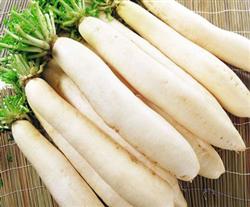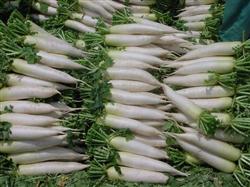Radish planting: how to plant radish listed in autumn and winter?

How to grow radish on the market in autumn and winter? Please introduce the planting method radish itself is a kind of semi-cold-tolerant vegetable, which is mild and cool, especially in the climate with large temperature difference. The optimum temperature for the growth of radish leaves is 15-20 ℃, and the optimum ground temperature for fleshy root expansion is 13-18 ℃. 1. Soil preparation and cultivation of radish should be based on base fertilizer, 70% of which should be based on base fertilizer. 70% of radish should be based on base fertilizer, which is mainly based on rotten barnyard manure, compost, human feces and urine, and phosphorus and potassium fertilizer (5000 kg per 667m2). Partial application of chemical fertilizer tastes bitter, single application of human feces and urine is not sweet, and easy to grow in vain. Deep ploughing 30 cm, broken soil flat ground, large radish is mostly high ridge cultivation, ridge spacing 50-60 cm, plant spacing 30 cm; small and medium-sized radish can be used flat bed, row spacing 17-20 cm, plant spacing 10-15 cm. Second, fine sowing autumn radish sowing early, serious diseases and insect pests, sowing too late, the yield decreased, so it is necessary to sow at the right time. Excellent varieties suitable for local growth should be selected. Fully watered when sowing, the soil water content should be 80%, and the soil cover should be 1.5-2 cm. The sowing amount is 500g-1000 g per 667m2, and the amount of radish on demand is less, about 400g-500g. After sowing, rainstorms often form soil consolidation, so the soil should be loosened and broken in time. 3. After Turnip Sprouts was unearthed, the cotyledons were unfolded for the first time, and 3-4 seedlings were left in each hole for burrow sowing. Grow to 2-3 true leaves when the second seedling, 4-5 true leaves when the third seedling, select strong seedlings. Appropriate amount of topdressing autumn and winter radish topdressing is generally three times, respectively in the seedling stage, rosette stage and fleshy root growth period, each time applied ammonium phosphate or compound fertilizer 10-20 kg per 667 square meters. Plant ash is best sprinkled in the field after watering in the peak growth period, applying 100 kg per 667 square meters. Fifth, watering seedlings at the right time can be watered with a small amount of water, and then ploughed to preserve soil moisture, and can be watered lightly in times of drought. The seedlings should not have much water before breaking their bellies, and they should be dry and wet. To the peak leaf growth period, after the fleshy roots begin to hypertrophy, they should be irrigated in a timely and appropriate amount, but they should not be irrigated until the soil epidermis turns white. The fleshy root should be fully and evenly supplied during the peak growth period, the effective water content of the soil should also be maintained at 70%, 80% and 80%, and the air relative humidity should be 80% or even 90% at best, so as to ensure high yield and high quality, and the fleshy root can also be watered appropriately in the later stage of growth. to prevent hollow. Most summer days are watered in the evening. Rain Water often pays attention to drainage. 6. Weeding and weeding should be carried out in the early stages of growth. Pull up the grass when you see the grass in the later stage. And the withered and yellow old leaves must be removed to facilitate ventilation. 7. The main diseases of ① radish are virus disease and black rot. The main method of virus disease is to control aphids and prevent high temperature and drought. Black rot is a disease caused by black rot fungus. the main symptoms are blackening of the root center and blackening and decay of the vascular bundles of the fleshy root. The pathogen overwintered on the seeds and remnants of diseased plants and was spread by Rain Water insects. Disease-resistant varieties should be selected, such as light green radish and heavy white radish. The seeds can also be soaked in 50 ℃ warm soup for 30 minutes, or the seeds can be soaked or sprayed with medicine solution. ② small land tiger can be sprayed with liquid medicine, or can be trapped and killed by heaping grass. Click for more radish planting techniques click to get more vegetable planting techniques
- Prev

Radish planting: how can autumn radish be planted with high yield?
How can autumn radish be planted with high yield? Please introduce the method of planting autumn radish can refer to the following methods: first, there are many varieties and planting time of radish. According to the season, it can be divided into four types: autumn radish, spring radish, summer radish and four seasons radish. Use the idle yard to grow autumn radish.
- Next

Radish planting: how to fertilize white radish?
How to fertilize white radish? Please introduce the method of fertilization radish absorption of nitrogen, phosphorus and potassium is slow at the initial stage of growth, and accelerates with growth. To the peak growth period of fleshy root, the absorption of nitrogen, phosphorus and potassium is the most. Radish in different growth stages of nitrogen, phosphorus and potassium absorption is very different, generally more nitrogen uptake at seedling stage, phosphorus.
Related
- Where is it suitable to grow horseradish in China? it is expected to see the middle altitude horseradish in Alishan.
- How to prevent tomato virus disease reasonably? (Control methods included)
- Many people like to plant towel gourd on the balcony. What are the main points of this method and management?
- What crops can chili peppers be mixed with?
- Fertilization techniques and matters needing attention in Tomato
- What are the grafting techniques for peach seedlings in spring?
- Harm and control methods of root swelling disease of Chinese cabbage
- What are the pests of sweet potatoes? How to prevent and cure it?
- Symptoms, causes and Control methods of navel Rot in Tomato
- The cause of "Cucumber rotten bibcock" in Farmers' planting Cucumber and its Control Plan

